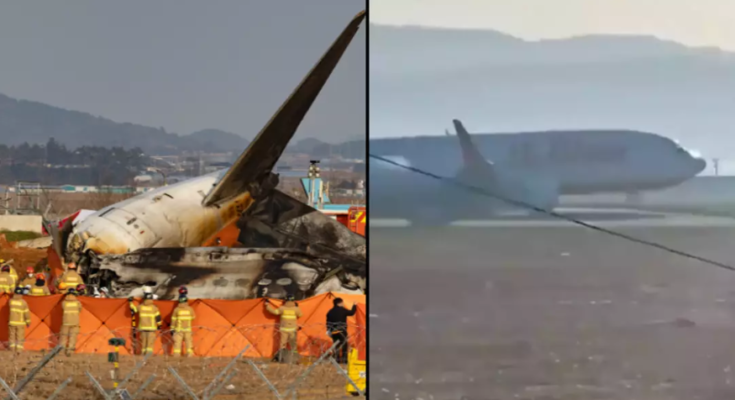Why there was concrete wall near runway that expert labelled ‘defining moment’ in plane crash that killed 179 people

An investigation is underway into the Jeju Air crash which killed all but two of the 181 people on board.
Authorities in South Korea are working to determine exactly what caused the tragic plane crash at Muan International Airport on Sunday (29 December) morning local time.
Shocking footage of the incident appeared to show the Boeing 737-800 jet skidding across the runway without having deployed its landing gear.
It then collided with a concrete wall near the end of the 2,800m runway and burst into flames.
The pilot of the plane, which had departed from Bangkok, Thailand, reported that it had struck a bird before the deadly crash, according to the BBC.
Investigators are now trying to find out what other factors may have played a part in the incident, including whether the aircraft’s control systems were disabled.
The plane’s black box has been retrieved from the wreckage, but is missing a key connector which will delay the data extraction from it, South Korea’s transport ministry said.
However, analysis of the cockpit voice recorder has now begun, which will hopefully provide a clearer picture of the final moments on board.

The Jeju Air plane burst into flames after smashing into a concrete wall (Chris Jung/NurPhoto via Getty Images)
Aviation experts have also been questioning why the ‘unusual’ concrete wall was located near the end of the runway.
The four-metre tall dirt-and-concrete embankment at the South Korean airport was part of a guidance system, which helps pilots land when visibility is poor or at night.
But according to David Learmount, who is the operations and safety editor of Flight International magazine and an aviation boffin, it’s positioning proved to be the ‘defining moment’ of the tragedy.
He believes that if the Boeing 737-800 had not hit the wall, it would have instead gone through a perimeter fence and across a road before coming to a stop in a nearby field.
“To have a hard object about 200m or less into the overrun, I’ve never seen anything like this anywhere ever before,” he told Sky News.
“There was plenty of space for the aircraft to have slowed down, come to a halt.
“And I think everybody would have been alive…the pilots might have suffered some damage going through the security fence or something like that.
“But I even suspect they might have survived.”
Lufthansa pilot Christian Beckert described the concrete wall as ‘unusual’ to Reuters, saying: “The reason so many people died was not the landing as such, but the fact that the aircraft collided with a very hard obstruction just beyond the runway end.
“Normally, on an airport with a runway at the end, you don’t have a wall.”

Aviation experts have been sharing their thoughts on the incident (X)
According to South Korea’s Yonhap News Agency, a navigation system which assists aircraft landings – known as a localiser – is inside of the concrete structure.
It is reported to have been raised and covered with dirt to keep this system level and ensure it works correctly.
At most airports, the instrument landing systems are placed on collapsible structures.
Another pilot with 48 years of experience, Chris Kingswood, explained that obstacles that are located ‘within a certain range and distance of the runway’ are required to be breakable.
“Which means that if an aircraft strikes them that they do break,” he told the BBC. “It does seem unusual that it’s such a rigid thing.”
He said that the alternate outcomes of the crash, specifically what might have happened if the wall wasn’t there, will ‘certainly [be] something that will be investigated’.
Kingswood added: “Aeroplanes are not strong structures – they are, by design, light to make them efficient in flight.
“They’re not really designed to go high-speed on its belly, so any kind of structure could cause the fuselage to break up and then be catastrophic.”
Discussion is also mounting around whether the pilots of the fateful Jeju Air flight even knew the barrier was there.
Aviation analyst Sally Gethin added: “We need to know, were [the pilots] aware there was this hard boundary at the end?
“If they were directed by the control tower to reverse the use of the runway the second time around, that should come out in the investigation of the black boxes.
“I think there are so many questions.”
What have Jeju Air and Boeing said about the crash?
In a statement, Boeing said: “We are in contact with Jeju Air regarding flight 2216 and stand ready to support them. We extend our deepest condolences to the families who lost loved ones, and our thoughts remain with the passengers and crew.”
Jeju Air also added: “We deeply apologize to all those affected by the incident. We will make every effort to resolve the situation. We sincerely regret the distress caused.”

The first words from one of the surviving members of doomed Jeju Air flight 7C2216 have been revealed after it crash landed at Muan International Airport on Sunday morning (29 December).
After travelling from Bnagkok Thailand, the Boeing 737-800 made an emergency landing in Muan, South Korea, 180 miles from Seoul, at 9:03 local time.
News footage of the Jeju Air aircraft skidding dangerously down the runway with no landing gear deployed showed how terrifying the situation was, before it collided with a concrete wall and burst into a giant fireball.
Eyewitnesses said that they heard a ‘series of explosions’ as well as ‘metallic scraping’.

The first words from survivors of the wreckage have been revealed (JUNG YEON-JE/AFP via Getty Images)
It has been reported that over 1,500 emergency personnel have been deployed in recovery efforts, as some have been searching for parts of the plane and bodies of passengers.
A number of them rushed to the crash site soon after, though it was reported by the BBC that only two of the 181 passengers and crew onboard survived, with both being crew members.
The South Korean National Fire Agency reported that the flight crew members, a man and a woman, survived, as they were found in the tail side of the plane and were swiftly taken to hospital.
The tail was the only recognisable part of the aircraft following the crash.
According to local news outlet Yonhap, the man is awake and ‘fully able to communicate’.
What were his first words?
When he was rescued and taken to hospital, the first thing the flight attendant, identified as Lee, said to doctors, was: “What happened?”
The crew member also asked: “Why am I here?”
He was said to look disoriented, and didn’t describe his injuries.
Lee, 32, clarified that he had his seatbelt on, and couldn’t remember events after the plane’s landing.

Authorities are still searching for debris and missing bodies (Chung Sung-Jun/Getty Images)
A hospital official explained what the problem may be: “It seems he was in a near-panic state, possibly worried about the safety of the plane and passengers.”
He was stationed at the rear of the plane to help passengers, though Yonhap report that he sustained a fractured left shoulder and head injuries while remaining conscious.
What about the other survivor?
The surviving woman has been identified as Kwon, a 25-year-old flight attendant that also cannot remember the crash.
Currently being treated at Mokpo Central Hospital, she told doctors that she had pain in her abdomen, ankle and head.
She also had a scalp laceration and a fractured ankle, according to hospital staff, who explained: “While her life is not in danger, we haven’t had time to ask her about the crash.”

Air traffic control issued a warning to the Jeju Air aircraft before it crash landed in Muan International Airport on Sunday (29 December).
The Boeing 737-800 had flown from Bangkok, Thailand and had attempted to land in Muan, South Korea, at 9:03am local time.
Footage of the crash shows the Jeju Air plane skidding down the runway with no landing gear seemingly deployed before it eventually collides with a concrete wall and bursting into flames, with eyewitnesses describing hearing a ‘series of explosions’ as well as ‘metallic scraping’.
Emergency services rushed to the plane wreckage soon after, though only two of the 181 passengers and crew onboard survived the crash. The only survivors were two crew members, who were recovered shortly after the crash on Sunday morning.

The Jeju Air plane was left unrecognisable (JUNG YEON-JE/AFP via Getty Images)
It was reported by several news outlets, including the BBC, that one of the late passengers sent a ‘heartbreaking’ final message to a family member about a bird being ‘stuck in the wing’ of the plane.
An investigation into the incident has revealed that the plane was given a bird strike warning from air traffic control minutes prior to the crash, The Guardian reports.
Yonhap News also reported that one of the surviving crew members had also mentioned a bird strike after being rescued from the wreckage.
The exact cause of the accident is still under investigation, however, it has drawn some eyes to Muan International Airport’s history of similarly tragic incidents, according to Yonhap.
The airport boasts the highest rate of bird strikes in South Korea’s 14 regional airports, with 10 incidents occurring between 2019 and August 2024, data submitted to the Korea Airports Corporation revealed.

The airplane burst into flames upon impact (X)
Its strike rate of 0.09 percent may seem small, but compared to Gimpo International Airport (0.018 percent) and Jeju International Airport (0.013 percent), it looks colossal.
Bird strikes can be life-threatening, according to aviation experts, and the reason behind Muan’s high rate is due to its close proximity to fields and coastal areas.
Aviation expert David Learmount explained to Sky News that those onboard could have survived, if not for the concrete wall.
He explained: “Not only is there no justification [for the wall to be there], I think it’s verging on criminal to have it there. That kind of structure should not be there. That is awful. That is unbelievably awful.
“He [the pilot] has brought it down beautifully given the circumstances, they are going very fast but the plane is still intact as it slides along the ground.”

The first words from one of the surviving members of doomed Jeju Air flight 7C2216 have been revealed after it crash landed at Muan International Airport on Sunday morning (29 December).
After travelling from Bnagkok Thailand, the Boeing 737-800 made an emergency landing in Muan, South Korea, 180 miles from Seoul, at 9:03 local time.
News footage of the Jeju Air aircraft skidding dangerously down the runway with no landing gear deployed showed how terrifying the situation was, before it collided with a concrete wall and burst into a giant fireball.
Eyewitnesses said that they heard a ‘series of explosions’ as well as ‘metallic scraping’.

The first words from survivors of the wreckage have been revealed (JUNG YEON-JE/AFP via Getty Images)
It has been reported that over 1,500 emergency personnel have been deployed in recovery efforts, as some have been searching for parts of the plane and bodies of passengers.
A number of them rushed to the crash site soon after, though it was reported by the BBC that only two of the 181 passengers and crew onboard survived, with both being crew members.
The South Korean National Fire Agency reported that the flight crew members, a man and a woman, survived, as they were found in the tail side of the plane and were swiftly taken to hospital.
The tail was the only recognisable part of the aircraft following the crash.
According to local news outlet Yonhap, the man is awake and ‘fully able to communicate’.
What were his first words?
When he was rescued and taken to hospital, the first thing the flight attendant, identified as Lee, said to doctors, was: “What happened?”
The crew member also asked: “Why am I here?”
He was said to look disoriented, and didn’t describe his injuries.
Lee, 32, clarified that he had his seatbelt on, and couldn’t remember events after the plane’s landing.

Authorities are still searching for debris and missing bodies (Chung Sung-Jun/Getty Images)
A hospital official explained what the problem may be: “It seems he was in a near-panic state, possibly worried about the safety of the plane and passengers.”
He was stationed at the rear of the plane to help passengers, though Yonhap report that he sustained a fractured left shoulder and head injuries while remaining conscious.
What about the other survivor?
The surviving woman has been identified as Kwon, a 25-year-old flight attendant that also cannot remember the crash.
Currently being treated at Mokpo Central Hospital, she told doctors that she had pain in her abdomen, ankle and head.
She also had a scalp laceration and a fractured ankle, according to hospital staff, who explained: “While her life is not in danger, we haven’t had time to ask her about the crash.”

One of the most tragic incidents in aviation history took place just over 30 years ago.
Aeroflot Flight 593 – carrying 63 passengers and 12 flight crew – was being flown by experienced airline captain Andrew Viktorovich Danilov of Russia back in 1994.
The 23 March flight successfully departured from Sheremetyevo International Airport in Moscow, Russia to Kai Tak Airport in Hong Kong shortly after midnight.
Danilov, who had 9,500 hours worth of in-flight experience, was joined by first officer Igor Vasilyevich Piskaryov (5,885 hours) and relief captain Yaroslav Vladimirovich Kudrinsky (8,940 hours).
Travelling on board were the captain’s two children on their first international trip with their father.
As the aircraft cruised towards its final destination on autopilot, the majority of its 63 passengers were asleep.
At 00:43, Kudrinsky’s daughter, 13, sat in her father’s seat, manually adjusting the autopilot’s heading setting so it made her feel like she was ‘flying’ the plane.
At 00:51, Kudrinsky let his son, 15 – for reasons unknown – essentially take control of the plane, possibly believing that because autopilot was controlling the aircraft, and that the 15-year-old’s actions would have no effect.
At 00:54, the teenager manipulated the control stick for over 30 seconds with inputs up to 10 kilograms, which contradicted the input made by the autopilot to keep the aircraft stable and straight, and changed the flight control settings to manual.

The plane was en-route to Hong Kong (YouTube/MorfoAtari)
Nobody onboard realised that he was in control of the aircraft but when autopilot tried to regain control, it conflicted with the boy’s controls, which had increased to inputs of 12 and 13 kg.
Eventually, this led to the disconnection of the autopilot servo from the aileron control linkage.
The pilots missed a non-audible warning light, as they had mostly flown Russian-built aircraft and were unfamiliar with the Airbus setup.
The aircraft then entered a bank, with the autopilot unable to maintain altitude due to the angle of the wings.
Captain Kudrinsky then ordered the co-pilot to take control as he got his son away from his seat so he could take command of the aircraft.
After re-adjusting his seat due to auto-pilot settings, the bank angle had increased to 90 degrees, with the A310 unable to turn from such a steep angle.

The plane lost control and eventually crashed, killing everyone onboard (YouTube/MorfoAtari)
With the pilots left to fend for themselves, they managed to recover the aircraft’s dive, though over corrected and sent the plane into an almost vertical climb, stalling and sending it into a spin.
It began to lose altitude, and eventually descended beneath the minimum safe altitude for the flight at the section of its route over mountainous terrain.
At 00:59, air traffic control in nearby Novokuznetsk were waiting for a position update through radio transmission from the flight, but it never came, as the flight stopped appearing on their radar screens.
It turns out that at 00:58, just two minutes and six seconds after the events unfolded, Flight 593 crashed in a flat altitude at high vertical speed, estimated to be around 160mph, in the Kuznetsk Alatau Mountain range in the Kemerovo Oblast region of southern Russia.
The aircraft was destroyed, killing everyone onboard.
Despite Aeroflot initially denying that the pilots were at fault, it was forced to change its account of events when a leaked copy of the cockpit voice recorder transcript was published.



